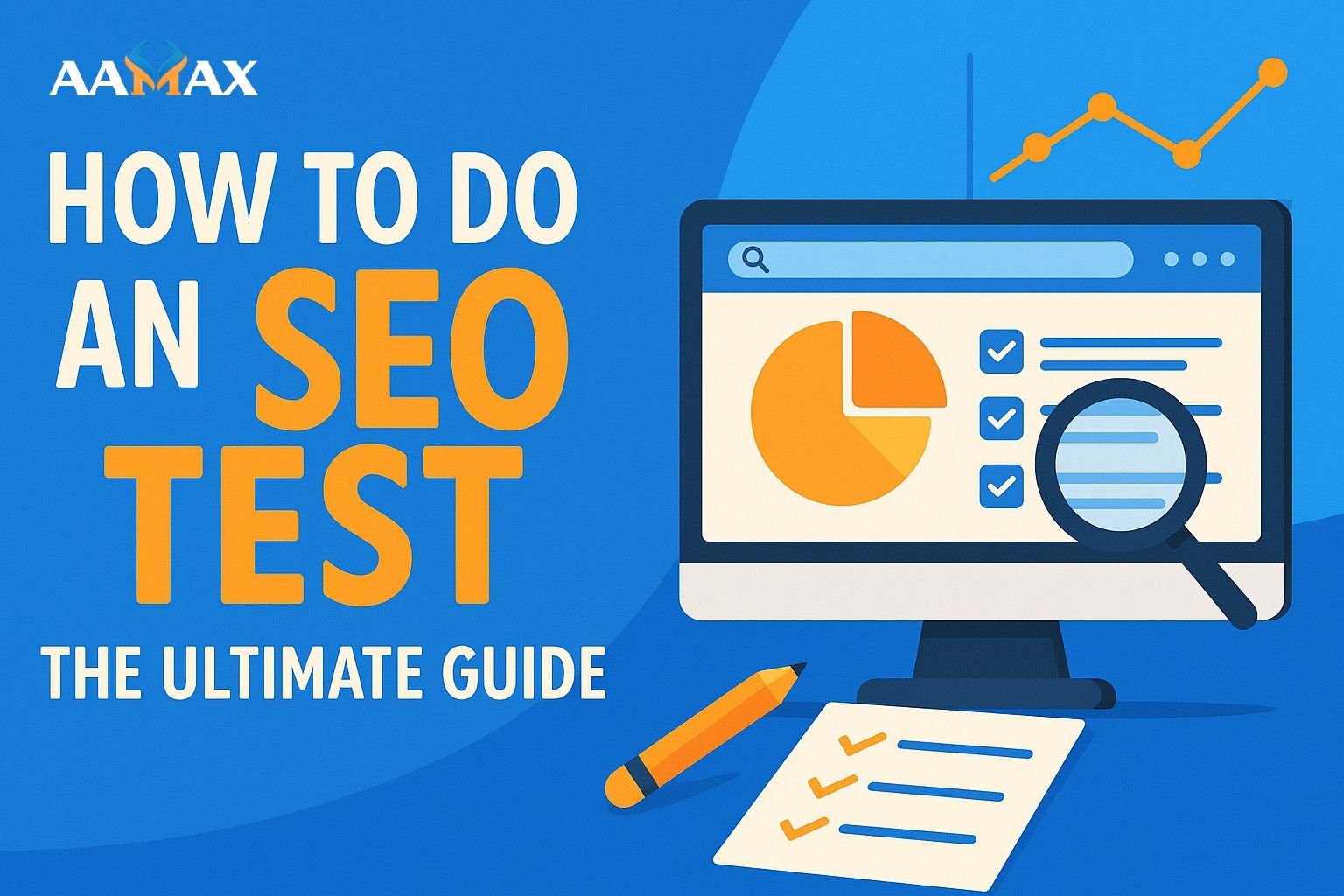
How to Do an SEO Test: The Ultimate Guide
In the competitive digital world, getting your website to rank higher on search engines isn’t a guessing game — it requires precise strategy, continuous optimization, and, most importantly, effective SEO testing. Whether you're managing a blog, an eCommerce store, or a corporate site, conducting an SEO test can uncover opportunities, fix issues, and validate strategies that drive real traffic.
In this ultimate guide, we will break down everything you need to know about running an SEO test: from preparation and execution to analysis and iteration. We'll also show you how professional help from a full-service agency like AAMAX can boost your SEO efforts.
What is an SEO Test?
An SEO test is a controlled experiment where you make changes to specific SEO elements on your website and monitor the impact on your search engine rankings, traffic, and engagement. The goal is to determine which optimizations actually help improve organic performance.
These tests help validate or debunk SEO theories and avoid wasting time on strategies that don’t yield measurable benefits.
Why Should You Run SEO Tests?
Running SEO tests provides the following benefits:
- Data-Driven Decisions: Avoid guesswork and base your SEO strategy on measurable results.
- Improved ROI: Focus your efforts on strategies that deliver traffic, engagement, and conversions.
- Identify Issues Early: Spot technical or on-page SEO problems before they severely impact rankings.
- Keep Up with Algorithm Updates: Test what works under Google’s latest algorithm changes.
Types of SEO Tests
There are various SEO elements you can test. Here are some common types:
1. Title Tag Tests
Test different title formats to see which brings higher click-through rates and better rankings.
- Example Test: “Best Shoes for Running” vs. “Top 10 Running Shoes for”
2. Meta Description Tests
Even though meta descriptions don't directly influence rankings, they impact CTR. Try experimenting with wording, CTAs, or even emojis.
3. Content Length & Structure
Does a 1,500-word blog post outperform a 700-word post? Try A/B testing content length or heading structures to see what works better for your audience.
4. Internal Linking Structure
Changing the internal link anchor text or the number of internal links to a specific page can influence how Google crawls and ranks content.
5. Page Speed and Core Web Vitals
Optimize your page speed and measure the impact on bounce rates and rankings. A/B test lazy loading, image compression, or caching.
6. Backlink Profile Changes
Although harder to test in isolation, a campaign targeting specific high-authority backlinks can be tracked for performance shifts.
7. Schema Markup Implementation
Structured data can impact SERP appearance. Test pages with and without schema to see if rich snippets affect your traffic.
Preparing for an SEO Test
Before diving into testing, preparation is key to ensuring valid results.
1. Choose the Right Page(s)
Select pages that already get moderate traffic but have room for improvement. Product pages, blog posts, or landing pages are great candidates.
2. Define Your Hypothesis
A clear hypothesis makes testing easier and more focused.
Example Hypothesis:
“Adding to blog post titles will increase organic CTR by 10% in 30 days.”
3. Establish a Control Group
For larger websites, test changes on a sample of pages while keeping others unchanged as a control group.
4. Set Up Tracking Tools
Use analytics and SEO tracking tools to gather baseline data and monitor performance:
- Google Analytics
- Google Search Console
- Ahrefs / SEMrush
- Screaming Frog (for crawl analysis)
- A/B testing platforms like Google Optimize or VWO
How to Run an SEO Test Step-by-Step
Follow this structured approach for a successful SEO test:
Step 1: Baseline Performance Audit
Use Google Search Console and SEO tools to capture baseline metrics for the page(s):
- Impressions
- Click-through rate
- Average position
- Organic sessions
- Bounce rate
Document this data before making any changes.
Step 2: Make the Change
Implement the search engine optimization tweak you're testing:
- Title tag
- Meta description
- Internal linking
- Content updates
- Page speed optimizations
Ensure changes are live and trackable.
Step 3: Wait & Monitor
Give your test enough time to collect data — typically 2–6 weeks depending on your website’s traffic levels and the change’s nature.
Step 4: Analyze Results
Compare performance metrics before and after the test. Use statistical significance testing when possible to ensure the results are not due to chance.
Look for:
- Increases in CTR
- Higher rankings
- More impressions
- Boost in conversions
Step 5: Iterate or Revert
- If the test is successful, roll out the change to more pages.
- If it doesn’t show improvement, revert the change and test another variation.
Best Practices for SEO Testing
To avoid errors and get the most out of your tests, follow these tips:
1. Test One Element at a Time
Avoid testing multiple variables at once unless you’re conducting multivariate testing. Isolating changes allows for cleaner analysis.
2. Track Metrics That Matter
Don’t just look at rankings — measure traffic, user behavior, and conversions. SEO is about business growth, not just vanity metrics.
3. Avoid Short Testing Windows
Give your test time to reflect in search engine rankings and user behavior. Impatient testing can lead to misleading conclusions.
4. Test Mobile and Desktop Separately
Mobile SEO may perform differently than desktop SEO. Use mobile-first indexing tools and monitor separately.
5. Document Everything
Keep logs of the hypothesis, date of implementation, test variations, and results. Documentation helps refine future testing.
Common SEO Testing Mistakes to Avoid
Avoid these pitfalls to ensure your tests are effective:
- Not setting a hypothesis
- Testing during peak or seasonal traffic spikes
- Ignoring external influences (e.g., Google updates)
- Failing to control for other marketing activities
- No post-test analysis
Example SEO Test Case
Let’s walk through a real-world example.
Situation:
A tech blog notices their articles on software tools have low CTRs despite decent rankings.
Hypothesis:
Adding the year to the title will increase clicks from search engine results.
Execution:
Change article title from “Top CRM Tools for Startups” to “Top CRM Tools for Startups.”
Results After 4 Weeks:
- CTR improved from 3.2% to 4.7%
- Position stayed relatively stable
- Organic traffic increased by 21%
Conclusion:
The new title format attracts more attention and should be implemented across similar content.
Tools You Can Use for SEO Testing
Here are some recommended tools to help with SEO experiments:
- Google Search Console – For monitoring search performance
- Google Analytics – Traffic, behavior, and conversions
- SEMrush / Ahrefs – Keyword tracking and backlink data
- Screaming Frog – Crawling and technical auditing
- Google Optimize – A/B testing and personalization
- Hotjar or Microsoft Clarity – User behavior insights (heatmaps, scrollmaps)
When to Hire SEO Experts
While small businesses can run some basic tests in-house, more complex or technical SEO experiments often require the expertise of professionals.
Consider hiring a digital marketing agency like AAMAX when:
- You want comprehensive SEO audits and data-driven strategy
- You lack time or expertise for implementation
- You need technical SEO fixes (e.g., Core Web Vitals)
- You’re scaling content and need consistent testing
- You want measurable ROI from SEO campaigns
AAMAX is a full-service digital marketing company offering expert Web Development, SEO Services, and Performance Marketing — making them a one-stop partner for your SEO needs.
Final Thoughts
SEO testing is not a one-time task — it’s an ongoing process that powers smart decisions and long-term growth. By running structured tests, analyzing your data, and refining your tactics, you can steadily improve your website’s performance in search engines.
Whether you're optimizing titles, testing new schema, or improving site speed, always ground your efforts in data and analysis. And if you’re ready to take your SEO to the next level, partnering with experienced professionals like AAMAX can help you get there faster and smarter.







